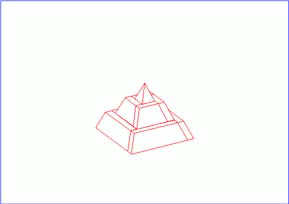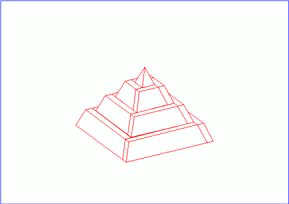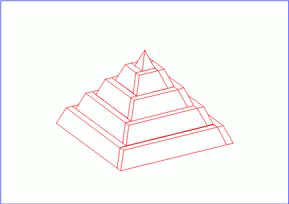Part 1 – General presentation
In 1997, put on the web a first site entitled: "CONSTRUCTIVE SYSTEM OF PYRAMIDS General presentation ", with the collaboration of B. THIEL / IPGP / University P. & M. CURIE, Paris-VI.
TECHNICAL CONTINUUM
Actually, the whole of edifices made of earth or stone, since the Neolithic era: cairn, tumulus, dolmen, fortified enclosure, ziggurat
[21]Note [21] - It is in fact not surprising to notice that the term “ziggourat” (siqquratu) has a “s.q.r.” root which means “to be high” or even “to raise” and that it is the same Hamito-semitic root than “Saqqarah” since it deals with the same shape, could we infer that it also has to do with the same building system? It however needs to be verified.
, mastabah, step-pyramid and sleek pyramid, tholos, torre, Mycenaean grave, stupa, etc . . . edifices necessitating important, even enormous, quantities of materials, and achieved with the most rudimentary technical means of extraction and lifting, even without scaffoldings, all pertain to the same method known as "accretion-raising" used when accomplishing the first rural picking of stones out of agricultural exploitations and fields, and maybe coming from this need of “gathering up the heaps” experienced by the first group of farmers-cattle breeders.
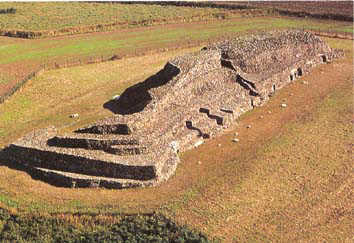 |
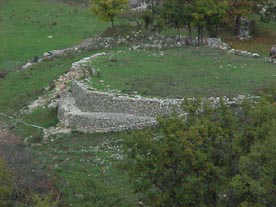 |
| Cairn in Barnenez (religious engineering) |
threshing area in Cipierre (rural engineering) |
As a matter of fact, this method is, from the start and by essence, anthropometrical, picking stones out of a pasture or a farming field generates a pile of stones which must be raised by hand, in order to take as little space as possible, the roughest stones are put inside facings made out of the nicest stones
[22]Note [22] - Archeology of the prehistoric buildings “Dolmens for the Deads” Roger JOUSSAUME 1985 Editions Hachette. All the dolmens in the world seem to have used this system, most of the time on a more or less mastered circular plan, however the dolmen of la Joselière in Pornic (Loire Atlantique, France) has the particularity to have been built on a square plan and to have two, maybe three parées, to the extend that it prefigures from a long time the upcoming step-pyramid.
.
A man's height is the anthropometrical limit. Then if you want to increase the heap, you have to add a peripheral facing on which to climb in order to continue to raise the edifice until one more man's height is reached , and so on and so forth. This method is called by us “accretion-raising” because only peripheral accretion allows to raise the heap; it explains A.Choisy's schema of construction by degree and imposes the concentric facings and the ascending degrees on these edifices.
This method was applied to the Egyptian step-pyramids
[23]Note [23] - Step-pyramid of Djoser in Saqqara is the most famous, it has supposedly been built by architect Imhotep. J.Ph. LAUER has been working for almost 70 years on this site without being able to come up with a satisfactory building explanation. It probably had 7 steps. It is from the analysis of this pyramid that Richard LEPSIUS will define the “accretion”, we suggest the “accretion-raising”, since the accretion is only motivated by the will to raise the building. However the correlation suggested by R. LEPSIUS, between the length of the Pharaoh's reign and the volume of the pyramid keeps whole its value. But it is also possible to consider that more than one king participated in the erection of the same building. This would explain most of the questions raised by the pyramid of Meidum.
and actually, the first principle “exploit all around and abound in the centre” and the second one "widening to raise" seems to have an universal value.
“Accretion-raising” system applied to any step-pyramid (like Saqqara)
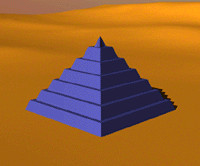
Place your mouse pointer over the image
A computer simulation of this method was done and can be applied to every step- pyramids. It allows to surmise that, whether they are small or large, solar temple or pyramid, they represent more or less advanced stages of a similar project. On the contrary, the Pyramid of Houni-Snefru in Meidoum and the Sekhem-khet both qualified as “unachieved” are nothing but in two more or less advanced stages of their destroying (schema).
And up to the way of thinking, the cosmogonic, theogonic and anthropogonic perception and representation of the world, as also the numerical notation of the growing arithmetic according to G. IFRAH
[24]Note [24] - Georges IFRAH “Universal story of numbers” (1981-1994) Editions Robert Laffont (p 394). The same way, the additional arithmetic learn by Pythagorus from the Egyptians, and that the Greek civilization will later deny and that will later be re- established by the Moderns, who will deduce from it the basics of contemporary Mathematical Theories, is only an adding game of series and sequences fit into each other.
, pertain to the same generic concept of increment through successive layers fitting into each, used in the building of the pyramids, to such an extend that it is quasi obvious that we face here the only way of thinking, conceiving and representing.
It is even possible to suggest, considering the conjunction of the realisations, that construction could have participated, or else generated the structuring of writing and of arithmetic.


